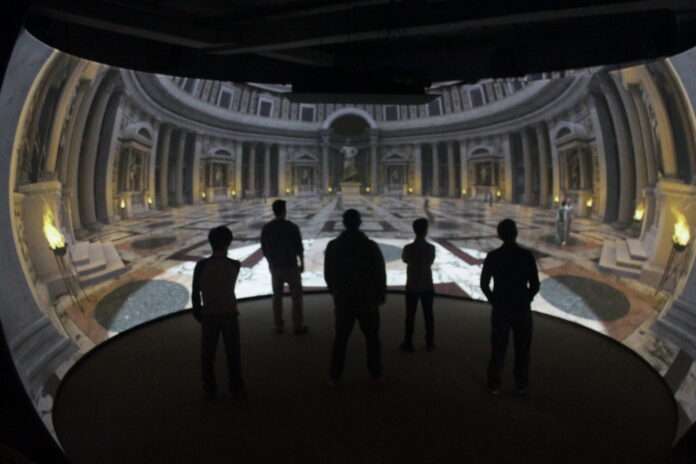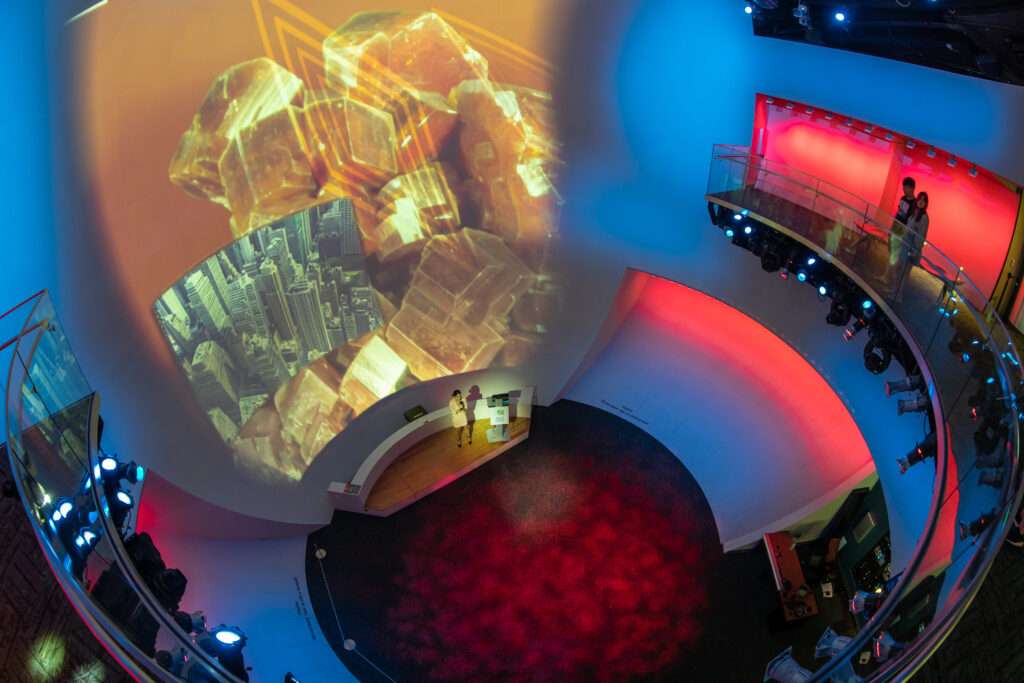Combining powerful technology and simple design for interactive, immersive experiences
by Wendy Grant
Immersive design and engineering firm The Elumenati celebrates its 20th anniversary in 2023. The company’s founders, Dr. D’nardo Colucci and Dr. David McConville, worked in virtual and augmented reality in the 1990s, and formed their own company in 2003. The Elumenati’s first products were fisheye-based projection systems; early consulting and custom installation projects included the Cambrian Seascape in the Field Museum’s Evolving Planet exhibition, which is still running today.
Today The Elumenati can boast having designed and deployed well over 700 systems, big and small. The company has installed its signature, turnkey GeoDome systems in venues around the world, while also providing custom work to clients in a range of education and entertainment markets, from museums and planetariums to location-based entertainment (LBE) and theme parks, and from traveling festivals and brand activations to aquariums and zoos. A sampling of their one-off projects includes an immersive theater at an amusement park in Qatar, a surf simulator for Richmond Olympic Experience that lets visitors virtually catch waves in the world’s best surf spots, and a holiday-themed brand activation for DreamWorks.
To help mark their 20th year, members of The Elumenati leadership team talked with InPark about their work, the design approach that they’ve honed over two decades, and what’s next for the specialized, boutique firm as they continue to forge their path as a pioneer in projection technology and immersive, interactive experiences.
Education and entertainment
From the beginning, The Elumenati has incorporated emerging technologies for interactive and real-time content into their systems. The company’s capabilities in systems integration and software development have been fed by the presence of Clayton Hooker and Dr. Clement Shimizu on the leadership team.
The company puts a special emphasis on creating social, collaborative ways to experience immersive content for clients in entertainment, education, and enterprise. “The entertainment space pushes us to innovate and emphasizes high production values – and fun!” says Vice President of Sales and Marketing, Hilary McVicker. “We bring those engaging experiences into the education world – museums, planetariums, and schools – and make learning dynamic and exciting.”
The team is especially proud of their projects that promote ecological literacy. They’ve worked extensively with both NOAA and NASA to bring content into GeoDomes used by the two agencies as well as Elumenati clients. WorldViewer, the Elumenati content management system (CMS), began as a way to showcase NOAA’s Science on a Sphere® datasets – hundreds of captivating animations of the Earth’s land, oceans, and atmosphere – for domes and other immersive environments. The Elumenati team are also development partners with NASA’s Jet Propulsion Laboratory on the Eyes On platforms, built in the Unity game engine, which lets audiences fly along with satellites.
Simplicity drives The Elumenati’s design philosophy. Their OmniFocus fisheye projectors surround audiences and optimize immersive space with imagery from a single projection channel. Their more complex blended systems are also driven from a single, image-generating computer. For example, in a recent update provided by The Elumenati to the SECU Daily Planet – a three-story theater at the North Carolina Museum of Natural Sciences – four media servers and a show control unit were replaced with just one machine that drives three projectors, manages blending and geometry correction, and supports both content creation and show control.
Support contracts ensure that clients stay up to date with the software, which constantly evolves in response to client feedback. Even as the technology changes, OmniFocus projection systems have an upgrade path that enables clients to continue using their lenses for new-generation projectors. When upgrade time comes, it’s much easier to swap out a single image-generating computer than a cluster of servers.
“It’s our goal to make the technology disappear and to deliver systems that are elegant, efficient, and easy for the operators to run, while the audience experiences complete immersion in the content,” says McVicker. Their goal is to leave clients empowered to run their systems on their own and refresh their own content with WorldViewer. “But we certainly are always here if they need us,” adds McVicker.
GeoDomes tell unique stories around the world
With the GeoDome line of turnkey solutions, customers choose from a variety of options to suit any space or use. There are two distinct configurations: immersive environments and globes. Each GeoDome features a screen or globe, a projection system with an OmniFocus lens, an image-generating computer, and the WorldViewer CMS. GeoDomes can be permanent or portable. The range of designs create different user experiences: from the Portal and Panorama for casual immersion, to fully enclosed Theaters and 360° Cycloramas. The GeoDome Evolver is The Elumenati planetarium solution, and the company supports a network of planetarium clients.
The line launched in 2008, and 15 years later, more than 100 GeoDomes are entertaining and educating audiences around the world. Recent GeoDome Globe installations show the diversity of applications: exhibits on biodiversity at Skansen in Sweden, on plate tectonics at the Science Museum Oklahoma, and helping tell the story of a company’s evolution at the Walmart Museum (Bentonville, Arkansas).
GeoDomes are widely used in museums and science centers, including such prestigious institutions as the American Museum of Natural History in New York City and Smithsonian venues in Washington, D.C. There are also several installations in zoos and aquariums and more expected on the horizon ahead as institutions and the public rally around conservation.

GeoDomes can also be found in more unexpected places, such as at sea. Eleven Princess Cruise Lines ships use GeoDome Theaters for all-ages programming, like onboard planetarium shows. GeoDomes also show up in trade show displays by corporate clients including Siemens, NVIDIA, and Deloitte.
The WorldViewer CMS is based on the Unity game engine, but no programming skills are needed, empowering clients to create and manage media for their GeoDomes while tapping into a huge variety of sources, including the Science on a Sphere library, Google Earth Studio, and the plethora of content created for virtual reality (VR). Audiences can experience that immersive content in docent-led presentations, user-driven interactives, or stand-alone playback mode. Elumenati software plug-ins support Unity and other real-time content, all driven from the WorldViewer interface. McVicker says, “It all adds up to a world of new possibilities for clients.”
Custom projects provide seamless solutions
“Custom projects give our creative team the opportunity to truly shine,” McVicker shares. “We start with the story the client wants to tell and build the user experience from there.”
Some projects require fully custom solutions – software, hardware, and user interface. For the Interactive Water Wall at the Children’s Pain and Palliative Clinic in Minneapolis, The Elumenati created a movement-driven experience projected onto curved walls that allows patients and families to create patterns in water, in a space that is both dynamic and contemplative.
For other projects, modifying a GeoDome system provides the solution. For ISODESIGN’s contribution to the StoryTrails touring experience, the largest immersive storytelling project ever produced in the UK, a GeoDome Panorama was optimized for pop-up and strike as the festival traveled to 15+ locations.
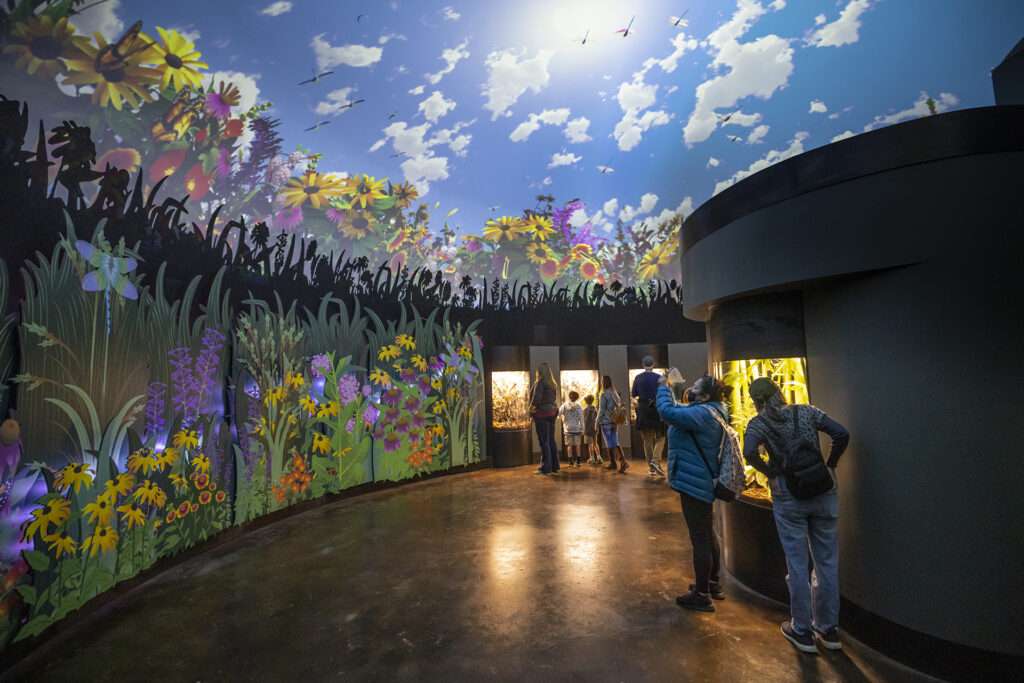
McVicker says, “Often a client comes to us as the technology experts to figure out the best path to execute their vision.” To enable audiences to see the world from a bug’s-eye-view at the San Diego Zoo Migrations experience at their new Wildlife Explorers Basecamp, a uniquely shaped dome is lit by a blended OmniFocus projection system. The content was built by a third party in the Unity game engine, which The Elumenati ported into WorldViewer and helped to integrate into a comprehensive CMS that powers more than 20 exhibits.
The Monterey Bay Aquarium team developed a hands-on interactive that displays life-sized models of the animals that live at the bottom of the sea and the technology their Research Institute uses to study them. Their “Into the Deep” exhibition needed OmniFocus projection in a customized configuration.
The Elumenati also custom-designed an immersive sleigh ride in branded Santa Houses for DreamWorks. Dozens of these interactive visits to the North Pole engaged mall visitors in the US and the UK over a two-year period.
Customized user interfaces are also an option. The Elumenati added gesture-based interactivity to their GeoDome Portal for the Cosmic Quest exhibit at Morehead Planetarium and Science Center (Chapel Hill, NC), allowing visitors to explore the universe, zoom in, and launch interpretive videos with a wave of the hand.
The creative team also develops exciting interactives such as The Broomstick Trainer, a four-person race. Players ride hand- built broomsticks on spring-loaded bases while audiences cheer them on in the 360° GeoDome Cyclorama. This multi-player technology can be repurposed to create a collaborative experience of any immersive content, for learning, creating, or pure fun.
“Our creative approach to user interface and user experience design brings emerging technologies from the videogame world into domes, panoramas, and globes,” notes McVicker. “We really believe interactivity is key to immersion.”
What’s next: OmniLED
The Elumenati company president Dr. Colucci earned his doctorate in optical science and has been awarded 10 patents. Despite his clear identity as an innovator, he would posit that he’s been making the same thing since 1996. “What’s changed,” he explains, “is the hardware and software for gaming, and projector technology, which has become smaller, brighter, cheaper, and higher resolution.”
LED represents the next major evolution in immersive displays, and once The Elumenati found a product that was up to their standards of quality, they launched their OmniLED line. OmniLED features flexible panels that create a smooth surface for compound-curved screens like their domes and globes.
While projection requires a controlled, dark space, the ultra-high brightness and contrast of LEDs can be used anywhere. “Often clients want to showcase their globe or Panorama as an attractor in bright lobbies or near windows, and now they can,” says McVicker. “As the technology evolves, it will replace projection in many cases.”
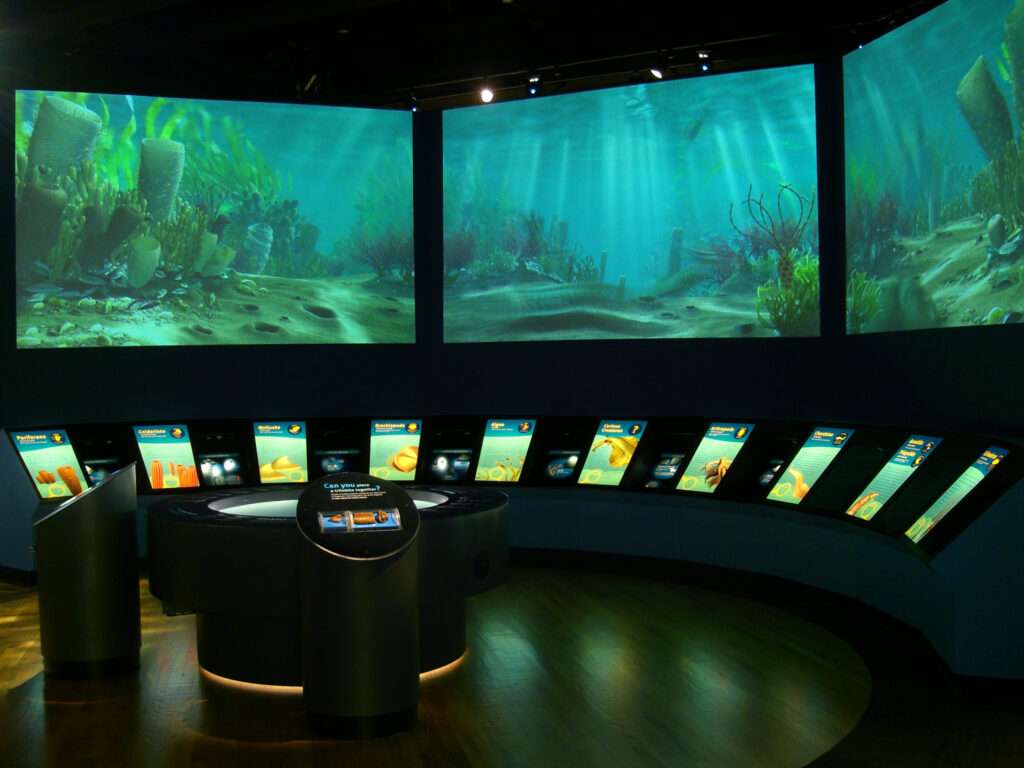
But she notes, “We are not just selling LED displays. We’re creating complete solutions using WorldViewer and applying the holistic approach to designing immersive experiences that we’ve honed over 20 years.” The Elumenati has a large globe installation going live early next year, and several more in the pipeline.
A genesis in virtual reality
Colucci and McConville both worked in the first wave of VR in the 1990s as part of the team at Alternate Realities Corporation, later known as Elumens. The team created the VisionDome, which was heralded as the world’s first fully immersive, multi-user, single- projection VR environment without glasses, goggles, or helmets. Its premiere at the 1998 World’s Fair in Lisbon, Portugal, saw 5,000 people visiting the pavilion daily and waiting hours to experience the VisionDome.
That same year, Colucci recalls, “Elumens accepted $30 million in venture capital – and all the creative handcuffs associated with it.” Colucci felt that VR was most powerful as a shared, group experience. He and McConville wanted to apply that immersive experience to the art and education worlds, so they left Elumens to form The Elumenati. Elumens went bankrupt in 2005. But The Elumenati went on to realize its vision. Colucci was able to purchase the fisheye lenses he’d designed while working at Elumens. He incorporated the lenses into The Elumenati’s first product line, the HAL-1200 projection system.
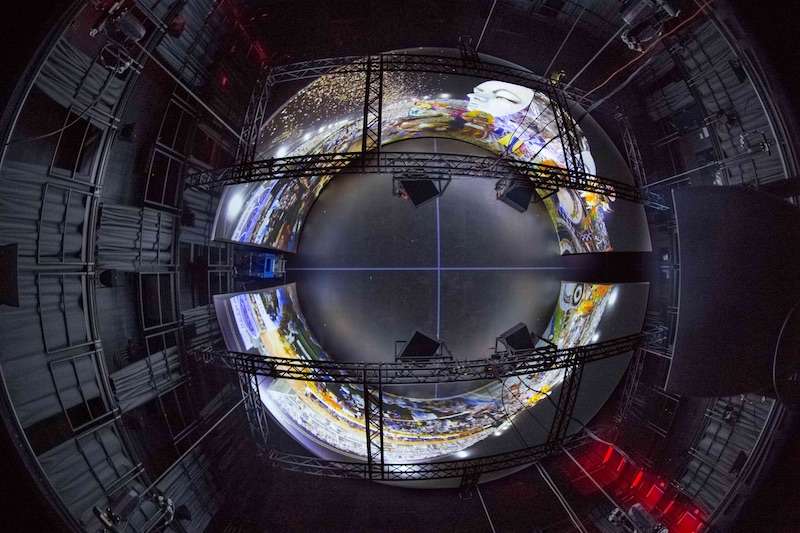
The revenue generated by that product allowed The Elumenati to design their first patented OmniFocus fisheye lenses, which drive Elumenati installations as well as customer and integrator projects. “I’ve also improved our fisheye lens designs with better image quality, lower cost, and higher versatility,” notes Colucci.
The key to success: client relationships
Looking at The Elumenati’s roster of projects over the years reveals that they’ve worked with many clients multiple times. “We are proud of how many of our clients come back for repeat business,” McVicker says. “We’ve built our reputation on our client relationships.”
What’s key to all of The Elumenati’s work, no matter where on the planet it’s located, is creating group immersive experiences that are social and collaborative. “Sharing an experience with your friends or family creates a reason to visit a venue. You might even connect with new people through that shared experience,” says McVicker. “And you’ll want to return again and again.” • • •


